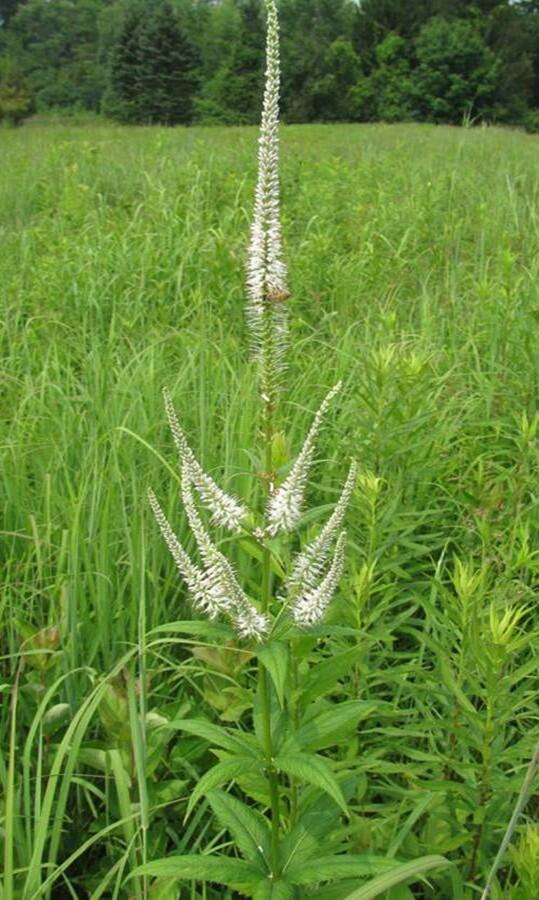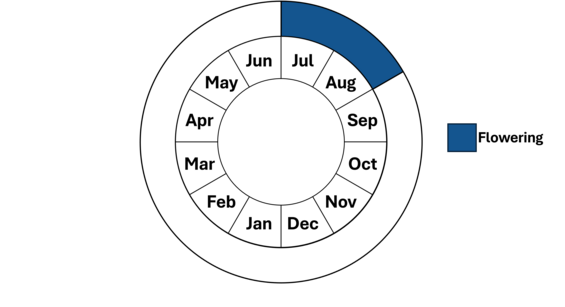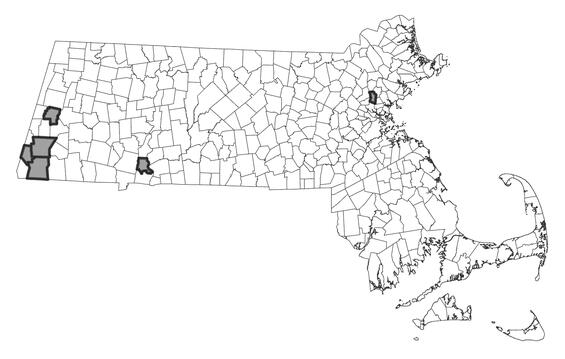- Scientific name: Veronicastrum virginicum (L.) Farw.
- Species of Greatest Conservation Need (MA State Wildlife Action Plan)
- Threatened (MA Endangered Species Act)
Description

Culver’s-root is an herbaceous perennial wildflower with several erect stems 8-20 dm (2.6-6.5 ft) in height, each terminating in showy, candelabra-like arrays of pink or white flowers. The stems bear numerous whorls of three to six leaves, which are narrow and somewhat stiff.
Culver’s-root has several stems, unbranched to the inflorescence, bearing whorls of lanceolate, finely serrate leaves that are usually slightly hairy beneath. Flowers are borne in branched, tapering terminal spikes 5-15 cm (2-6 in) long. The flowers are tubular in shape, 7-9 mm (0.3-0.4 in) long, and densely crowded on each spike.
There are many native, naturalized, and cultivated species with showy terminal white or pink inflorescences, but none with culver’s-root’s combination of tall stature, unbranched erect stems, narrow whorled leaves, and candelabra-like inflorescence.
Life cycle and behavior
This is a perennial species.

Population status
Culver’s-root is listed under the Massachusetts Endangered Species Act as threatened. All listed species are protected from killing, collecting, possessing, or sale and from activities that would destroy habitat and thus directly or indirectly cause mortality or disrupt critical behaviors. There are currently 7 occurrences known in Berkshire, Hampden, and Middlesex Counties. Two of those occurrences are thought to be introductions, with an unknown seed source. Sites in which the plant may have been introduced are not regulated.
Distribution and abundance
Culver’s-root is known throughout much of eastern and central North America from Nova Scotia and New England west to Manitoba and the Dakotas, south to Texas, and the Gulf states. It is critically imperiled or imperiled in 13 states. In New England, it is critically imperiled in Vermont, imperiled in Massachusetts, not assessed in Connecticut and introduced in Maine. It is not known to occur in either New Hampshire or Rhode Island (NatureServe 2025).

Distribution in Massachusetts. 1999-2024. Based on records in the Natural Heritage Database.
Habitat
In Massachusetts, culver’s-root typically inhabits moist, sunlit meadows, often formerly cultivated, with alkaline soils. Populations have also been found along a roadside and in a moist utility right-of-way. Associated species include goldenrods (e.g., Solidago canadensis, S. altissima), asters (Symphyotrichum spp.), spotted Joe-Pye-weed (Eutrochium maculatum), wild bergamot (Monarda fistulosa), sensitive fern (Onoclea sensibilis), and other wet meadow species. Associated shrubs may include northern arrowwood (Viburnum dentatum var. lucidum), witherod (V. nudum var. cassinoides), willows (Salix spp.), and alders (Alnus spp.). Habitat is often kept open by some form of disturbance such as periodic flooding, mowing, or grazing.
Healthy habitats are vital for supporting native wildlife and plants. Explore habitats and learn about conservation and restoration in Massachusetts.
Threats
In Massachusetts, culver’s-root faces a number of threats. These include development of habitat, predation by deer, invasion by exotic plants, competition from native woody plants, soil bank erosion in riparian habitats, impact from agricultural herbicides, poorly timed mowing, and road runoff. Exotic buckthorns (Rhamnus cathartica and Frangula alnus), honeysuckles (Lonicera spp.), multiflora rose (Rosa multiflora), Japanese barberry (Berberis thunbergii), privet (Ligustrum sp.), autumn olive (Elaeagnus umbellata), Asiatic bittersweet (Celastrus orbiculatus) and purple loosestrife (Lythrum salicaria) have been noted at population locations; these species and native woody plants (e.g., alders) can potentially outcompete culver’s-root.
Conservation
Woody plants should be monitored and, if deemed necessary, a vegetation management plan should be developed in consultation with MassWildlife’s Natural Heritage and Endangered Species Program. Mowing should be timed to allow completion of flowering and fruiting of culver’s-root, and if possible, should take place during the growing season to better control woody plants; therefore, spring and autumn (post-fruiting) are the best times to mow. Sites should also be monitored for deer browse, and if necessary, measures such as fencing may be used to protect plants. Where erosion is a problem, it may be necessary to expand habitat away from eroding banks through vegetation management. All active management of rare plant populations (including invasive species removal) is subject to review under the Massachusetts Endangered Species Act and should be planned in close consultation with MassWildlife’s Natural Heritage and Endangered Species Program.
References
Gleason, Henry A., and Arthur Cronquist. Manual of Vascular Plants of Northeastern United States and Adjacent Canada, Second Edition. Bronx, NY: The New York Botanical Garden, 1991.
Haines, A. 2011. Flora Novae Angliae – a Manual for the Identification of Native and Naturalized Higher Vascular Plants of New England. New England Wildflower Society, Yale Univ. Press, New Haven, CT.
NatureServe. 2025. NatureServe Network Biodiversity Location Data accessed through NatureServe Explorer [web application]. NatureServe, Arlington, Virginia. Available https://explorer.natureserve.org/. Accessed: 6/3/2025.
POWO (2025). Plants of the World Online. Facilitated by the Royal Botanic Gardens, Kew. Published on the Internet; https://powo.science.kew.org/ Accessed: 6/3/2025.
Contact
| Date published: | May 7, 2025 |
|---|